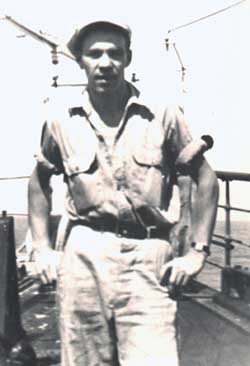INTRODUCTION

Charles E. "Chuck" Betsworth in1949
|
|
Welcome to
the homepage of Canadian Merchant Navy Veteran,
Charles E. "Chuck" Betsworth
who
served aboard a variety of merchant
ships during World War Two.
During his last wartime voyage, made
aboard the freighter
SS
Sapperton Park
in April and May 1945, Chuck was able
to take along a small camera
and one film with which he recorded
Sapperton Park's jey
across the North Atlantic.
Chuck joined the
Canadian Merchant Navy
in 1942, when he was a lad of 15. He worked on
the British Columbia coast
for the Union Steamship Company
and then for the
Canadian Pacific Steamship Company (CPSS) and
the
Canadian National Steamship Company
(CNSS) before
going foreign in 1943. His first deep-sea vessel was the
Imperial Oil
tanker, SS Ontariolite,
followed by nearly a year on the
Norwegian motor tanker
MS Pan Europe.
In March 1944
Pan Europe voyaged to
Eniwetok Atoll in the Marshall Islands
where she
supplied fuel to the American naval ships
which had helped secure the atoll in the previous month.
After his service on Pan Europe
Chuck sailed on the Imperial Oil tanker SS
Albertolite, before he joined the
Vancouver Manning Pool
and was assigned to
Sapperton Park
. Sapperton Park
was
one of the three hundred and fifty-four
10,000 Dead Weight Ton (DWT)
merchant vessels which were built in Canadian shipyards
during the war. She was launched
by
Burrard Dry Dock/Vancouver Dry Dock in
Vancouver, British Columbia as the
Fort Toulouse (Hull #195) on January 7, 1944.
She was intended to be transferred to Britain's
Ministry of War Transport (MOWT), and when
it was decided to keep her as part of the
Canadian "Park" fleet instead,
she was completed as Sapperton Park.
When Sapperton Park
made her maiden
voyage, she had among her personnel, some very unique
merchant sailors:
her Skipper,
Captain John Vosper,
her Bosun, Frank Culbard, and her Second/
Third Mate, Jack Ickringill.
All these men had
the distinction of having recently sailed on one of the last
deep-sea
sailing ships, the five-masted schooner
City of Alberni,
when she made an abortive
attempt to round Cape Horn. By time
Chuck joined Sapperton Park,
the Bosun's job had been taken over
by Cyril (Cy) Dolga, a survivor
of the March 1943 sinking of the CPR troopship,
Empress of Canada.
When Chuck signed aboard
Sapperton Park on April 4th, 1945,
her holds were filled with lead-zinc ingots. She then

Canadian Merchant Navy Badge
|
sailed to the Vancouver Island ports of Chemainus
and Port Alberni
to receive a deck-load of B.C. lumber.
Then as was customary in this area of the Pacific,
Sapperton Park set off by herself down the
Pacific Coast on the first
stage of her journey to Britain. Although by this
time the end of the
war with Germany was in sight,
the U-boats that were still at large remained a deadly threat
to both merchant and naval vessels, especially
those on their own. On April 16th, 1945, just around the
time that Sapperton Park left Port Alberni,
the Canadian minesweeper, HMCS Esquimalt
was torpedoed in the Halifax approaches
by
U-190. Esquimalt had been patrolling
on her own when she was attacked and although she was close
to Halifax, only 23 of the 70 on board her survived.
Sapperton Park's crew
remained vigilant as they travelled down to the
Panama Canal, where Chuck's photos begin.
|
Voyage of a Merchant Sailor is continued in
Part 2
|
|
